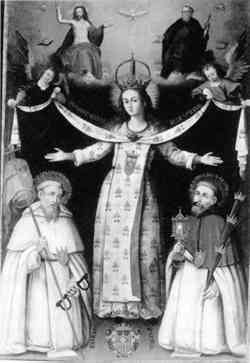BLUE PIGMENTS IN SOUTH AMERICAN PAINTING (1610–1780)ALICIA M. SELDES, JOS� EMILIO BURUC�A, MARTA S. MAIER, GONZALO ABAD, ANDREA J�UREGUI, & GABRIELA SIRACUSANO
6 CONCLUSIONSIndigo and Prussian blue, the latter not before 1770, seem to have been the blue pigments most employed in the workshops of Cuzco in the 18th century. Note that Prussian blue, discovered in Europe in 1704 and spread through the Old World in the 1720s, has not been registered until now in any Cuzco work dated clearly before 1770. This finding coincides approximately with our oldest documented record of this pigment in South America in 1789. The use of azurite is noteworthy in the city of C�rdoba at the beginning of the 17th century. The grinding of azurite used in paintings dating since the end of the 17th century appears to be a quite different process, probably of Central or South American origin. This pigment, probably local, appears in three works attributed to Mateo Pisarro and his workshop, installed in the estate of the Marqu�s del Valle de Tojo on the Puna de Smalt was widely used by Pisarro and his assistants. Smalt is also recorded in works coming from P�rez Holgu�n's workshop in Potos� (dating from the late 17th and early 18th centuries). Thus it is possible to entertain the hypothesis (also supported in shared subtleties of pictorial execution) that there was perhaps a teacher-student relationship between P�rez Holgu�n and Pisarro; the latter is known to have passed through Potos� in 1691 (Academia Nacional de Bellas Artes 1991, 11). Only three paintings originating in Cuzco and painted in the 18th century reveal smalt in the blues. The combination of pigments in different layers of paint rarely occurs on the same canvas. This technique is clearly established only in an unusual piece from Cuzco (exceptional for the iconography of a Circumcision located on the rock of Nativity rather than in the Temple), painted perhaps in the 17th century. In this painting we found azurite and smalt in different sectors of the canvas. However, as noted in the appendix, there are some indications of a possible use of indigo and azurite in successive layers (Cuzco, first half of the 18th century), or indigo and smalt (Puna, first half of the 18th century), or indigo and Prussian blue (Cuzco, second half of the 18th century). If this is true, it might be inferred that the ideas of Spanish authors such as Pacheco and Palomino, who recommended the use of several pigments in different phases of the work with color, had been known in the workshops of South America. Evidence is found in the writing of Manuel de Samaniego of Quito, who in the late 18th and early 19th centuries took the technical definitions from classic Spanish writers on art and added information drawn from his own experience with Prussian blue. A single case among the 106 studied—Our Lady of Mercy, with
This group of paintings as a whole reveals the broad knowledge and great experimental and inventive capacity of South American artists in the matter of pigments. They had to solve the aesthetic problems that arose in the appropriation and reworking of European models that almost always reached them in black and white. This challenge is reflected in Samaniego's Tratado de la pintura, first published in 1944 (Vargas [1944] 1975). Properly speaking, it seems to be more of a personal notebook for use in the author's practice of painting and in his teaching rather than a treatise; it contains summaries of fragments drawn from the Spanish authorities. It is significant that the most original parts of his work are his advice and recipes for depicting the flesh of the figures and his notes on making colors derived from his own experience as a painter. All this helps us to understand and appreciate the practice of those who, like Pisarro, working at a great distance from urban centers such as Cuzco, Potos�, or C�rdoba, were able to display invention and originality in the employment and mixture of pigments. |
